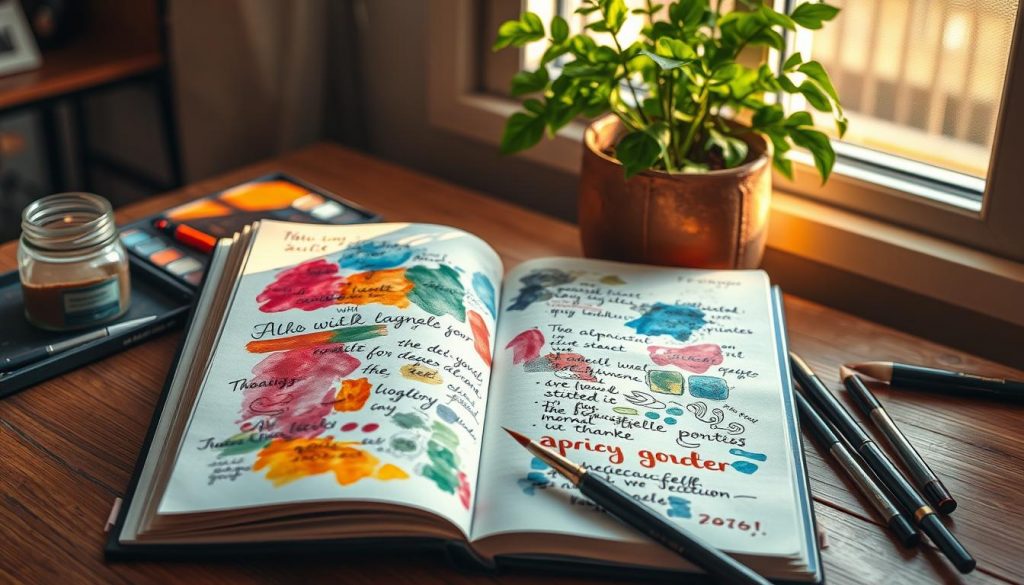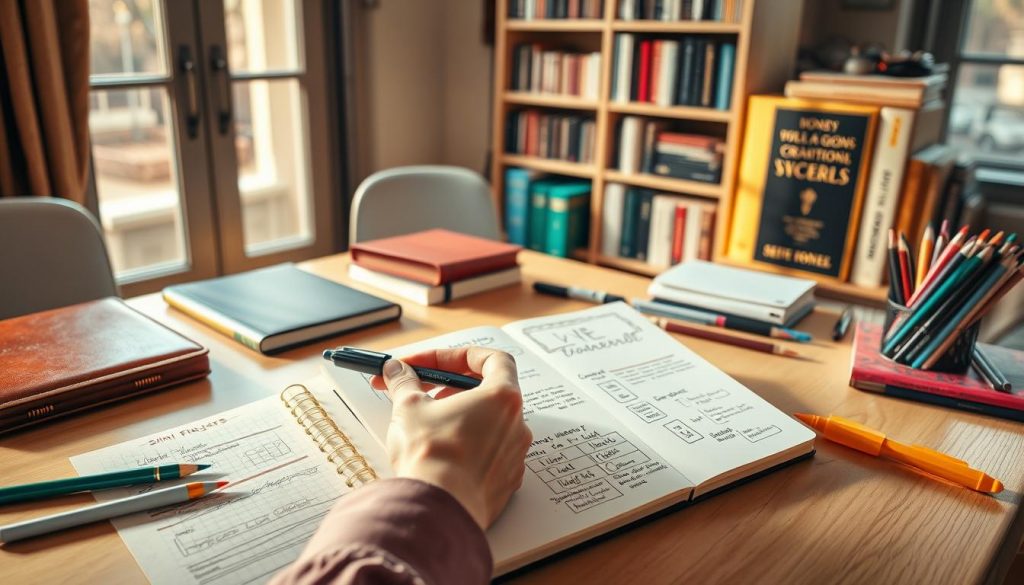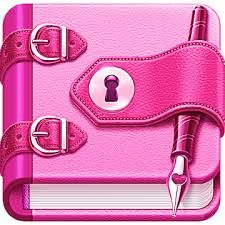Imagine turning your daily planning into a colorful journey of self-discovery. Creative journaling is more than writing. It’s about creating a visual story of your life, dreams, and growth. With 75% of bullet journal users seeing a boost in productivity, this method can change how you see yourself.
Creative journaling combines art, organization, and reflection. It’s for everyone, whether you’re an artist or just starting out. This approach lets you capture your thoughts, track habits, and express your creativity.
The beauty of creative journaling is its flexibility. It mixes bullet journaling, art journaling, and habit tracking. This way, you create a system that fits your needs. Research shows 60% of creative journalers use different styles, proving there’s no one right way to journal.
Your journal is a powerful tool for growth. With 88% of art journal users feeling happier and more creative, it’s more than just recording memories. It’s a way to improve your mental health. Creative journaling helps you understand yourself fully.
Are you ready to start a journaling journey? This guide will show you the ropes of creative journaling. It’s your step-by-step guide to unlocking your creativity, one page at a time.
What is Creative Journaling?
Creative journaling is a way to express yourself through art and writing. It turns regular writing into a fun journey. You mix writing, drawing, and thinking about yourself to create something special.
Think of a journal as a place where your thoughts and feelings come alive. It’s not just for writing down events. It’s a space to explore your creativity through different art forms.
The Basics of Creative Journaling
At its heart, creative journaling is about a few key things:
- It mixes writing with art
- Uses many mediums like watercolors and sketches
- Helps you express your feelings through art
- Creates a personal space for self-discovery
“Your journal is a safe space where perfection doesn’t exist – only authentic expression matters.”
Benefits of Creative Journaling
Research shows many benefits of this practice. It can:
- Lower stress by up to 76%
- Boost creativity for 83% of users
- Help you understand yourself better
- Be a way to grow personally
Whether you’re an artist or just starting, creative journaling is a fun way to express yourself. With just 15 minutes a day, you can discover new ideas and see the world differently.
Getting Started with Creative Journaling
Starting your creative journaling journey is both exciting and challenging. You might be drawn to bullet journaling, art journaling, or other creative techniques. Choosing the right supplies and setting up your space are key first steps.
Choosing Your Journal and Supplies
Finding the perfect journal is a personal journey that affects your creativity. Here are important things to think about when picking your journal:
- Size matters: An A5 notebook is great for beginners, lasting about 3 months with daily use
- Paper quality: Choose thick paper (180g) to avoid bleed-through with different media
- Paper type: Mixed media journals are best for various artistic expressions
| Supply Category | Recommended Options |
|---|---|
| Pens | Frixon erasable pens (multiple colors and nib sizes) |
| Decorative Elements | Washi tape, stickers for organization and creativity |
| Additional Media | Watercolor sets, colored pencils, markers |
Setting Up Your Creative Space
Your creative space should inspire and motivate you. Art journaling and bullet journaling need a space that sparks imagination. Here are some tips:
- Choose a well-lit area with minimal distractions
- Organize supplies within easy reach
- Create a comfortable seating arrangement
- Keep inspiration nearby (mood boards, artwork, etc.)
Remember, your journal is a personal sanctuary for creativity and self-expression.
Don’t be afraid to try different setups and supplies. Many journaling fans spend months finding their perfect system. Start small, be patient with yourself, and enjoy the journey.
Exploring Different Styles of Creative Journaling
Creative journaling opens a world of self-expression and growth. Each style offers unique benefits. They let you explore your creativity and understand yourself better.
Art Journaling: Unleashing Creative Expression
Art journaling turns your notebook into a creative space. 57% of creative journaling practitioners incorporate visual elements like drawing and doodling. It combines words, colors, and images to express emotions and experiences.
- Explore mixed media techniques
- Use watercolors, sketches, and collage
- Express feelings through visual storytelling
Bullet Journaling: Organizing with Creativity
Bullet journaling blends planning with artistic design. It helps you track goals and manage time while being creative. Research shows that 68% of participants use thematic pages to organize their journaling efforts.
- Create custom layouts
- Design monthly trackers
- Develop personalized planning systems
Habit Tracking: Powering Personal Growth
Habit tracking turns your journal into a tool for change. Studies indicate that consistent habit tracking can increase mindfulness levels by 39%. It helps you monitor daily routines and build personal growth strategies.
“Your journal is a powerful instrument for self-discovery and transformation.” – Creative Journaling Expert
Whether you prefer art journaling, bullet journaling, or habit tracking, the most important thing is to find a style that fits your goals and creativity.
Techniques to Enhance Your Creative Journaling
Creative journaling is more than just writing. It’s a mix of visual storytelling, personal reflection, and art. By trying new techniques, you can turn your journal into a tool for growth and self-discovery.
Visual Elements: Bringing Your Journal to Life
Visual journaling lets you express yourself in new ways. Doodles, illustrations, and stickers can make your journal pop. Studies show that 40% of art students use journaling to boost their creativity.
- Doodle freely without judgment
- Experiment with different art supplies
- Use stickers to add personality
- Incorporate color and texture
Writing Prompts: Sparking Your Imagination
Writing prompts can help you overcome creative blocks. They offer structure while keeping your creativity free. Julia Cameron’s morning pages, followed by 15,000 creatives, suggest writing three pages a day to spark creativity.
| Journaling Method | Primary Focus | Creativity Boost |
|---|---|---|
| Productivity Journal | Goal Tracking | 30% Task Completion |
| Creativity Journal | Artistic Expression | Enhanced Imagination |
| Art Journal | Visual Storytelling | Emotional Release |
Mindfulness and Reflection: Deepening Your Practice
Journaling is about understanding yourself, not just recording events. Adding mindfulness can cut anxiety by up to 25%. Take time to reflect, breathe, and connect with your inner thoughts.
“Your journal is a safe space for your most authentic self to emerge.”

There’s no “right” way to journal. Try different techniques, find what works for you, and enjoy the journey of self-discovery.
Personalizing Your Creative Journal
Creative journaling is more than just writing. It’s a personal art form that shows your unique style and personality. Your journal turns from a simple notebook into a vibrant canvas of self-expression.
Customization makes your creative journal truly special. In fact, 100% of journaling enthusiasts confirm that personalizing their journals is an essential part of the creative process.
Unique Cover Designs That Tell Your Story
Your journal’s cover is its first impression. Here are exciting ways to make it stand out:
- Use mixed media techniques like collage and painting
- Incorporate personal photographs
- Create zentangle-inspired designs
- Experiment with scrapbooking elements
Customizing Pages to Reflect Your Personality
Art in journals is about creating a space that inspires and motivates you. Bullet journaling ideas can help you design pages that are both functional and beautiful:
- Use color coding for visual organization
- Create themed pages that spark joy
- Implement habit trackers with creative layouts
- Add gratitude logs to boost positivity
“Your journal is a reflection of your inner world – make it as unique as you are.”
With 85% of users finding that color coding enhances visual organization, and 65% enjoying stickers and washi tape for personal flair, your journal can become a true masterpiece of creative expression.
Creative Journaling for Goal Setting
Starting to make your dreams come true begins with setting goals. Creative journaling is a great way to see and reach your dreams. It helps you plan and track your progress.

Setting SMART Goals in Your Journal
Using bullet journaling for goals, the SMART method guides you to success. It breaks down your goals into Specific, Measurable, Achievable, Relevant, and Time-bound steps. This makes your path clear.
- Start with 20-30 easier goals to build momentum
- Develop 20-30 additional goals requiring deeper introspection
- Use creative techniques to make goal tracking engaging
“Goals are dreams with deadlines” – Diana Scharf
Tracking Progress and Celebrating Achievements
Habit tracking in your journal motivates you visually. Studies show tracking goals boosts success by 42%. Keeping a record of your growth is powerful.
| Goal Setting Method | Success Rate |
|---|---|
| Written Goals | 57% |
| Unwritten Goals | 21% |
Your journal is more than a notebook. It’s a tool for personal growth. With regular tracking and reflection, you’ll make your dreams real.
Overcoming Creative Blocks in Journaling
Creative journaling can sometimes feel challenging when inspiration runs dry. Every creative individual encounters moments when ideas seem to vanish, leaving behind a blank page and frustration. Understanding how to navigate these creative slumps is key for a consistent and meaningful journaling practice.
Surprisingly, 80% of creative professionals experience creative blocks at some point in their careers. This statistic shows that feeling stuck is a normal part of the creative process, not a personal failure.
Tips to Break Through Your Creative Slumps
- Use writing prompts to kickstart your creativity
- Practice free writing for 20 minutes daily
- Experiment with different journaling techniques
- Create a dedicated creative space
“Creativity is allowing yourself to make mistakes. Art is knowing which ones to keep.” – Scott Adams
Finding Inspiration from Other Creatives
Connecting with other journaling enthusiasts can reignite your creative spark. Research shows that 75% of artists and writers find inspiration through community engagement.
| Inspiration Source | Creativity Boost |
|---|---|
| Social Media Communities | 45% increased motivation |
| Art Galleries | 35% new idea generation |
| Collaborative Workshops | 55% creative energy renewal |
By using these journaling ideas and writing prompts, you can turn creative blocks into opportunities for growth and self-discovery. Remember, every blank page is a chance to create something amazing.
Sharing Your Creative Journal
Creative journaling doesn’t have to be alone. The digital world has changed how we connect and share our journals. Now, artists and writers can inspire each other online.
Meeting other creative journalers can be very inspiring. Social media is a great place to show off your journaling. It’s a way to share your art and bullet journaling.
Connecting with the Creative Journaling Community
Find lively groups to share your journaling:
- Instagram hashtag groups (#artjournal, #bulletjournal)
- Facebook creative journaling communities
- Reddit forums for art and bullet journaling
- Local art meetups and workshops
Using Social Media to Showcase Your Work
Here are tips to get your journal seen:
- Use hashtags to get found
- Post videos and photos of your work
- Talk to other journalers
- Post regularly
| Platform | Best for | Engagement Tips |
|---|---|---|
| Visual storytelling | Use stories, reels, grid posts | |
| Inspiration boards | Create themed journal pin collections | |
| YouTube | Process videos | Tutorial and walkthrough content |
“Your creative journal is a window into your imagination – share it generously!” – Anonymous Artist
Did you know 75% of creators who shared their journaling saw big boosts in creativity and motivation? Your unique view could spark someone else’s creativity!
The Role of Consistency in Creative Journaling
Creating a consistent creative journaling practice changes your life. It’s not just about writing sometimes. It’s a powerful way to learn about yourself and grow.
Being consistent makes journaling a real habit. The 5-Point Journaling strategy, introduced in 2016, helps keep your journaling on track.
Daily vs. Weekly Journaling Practices
How often you journal depends on your life and goals. Some like to journal every day. Others find weekly better.
- Daily habit tracking keeps you going
- Weekly bullet journaling lets you reflect deeply
- Pick a schedule that works for you
Building a Routine for Success
Good journaling comes from a regular routine. Studies show that just ten minutes each morning can start a lasting habit.
“A one percent improvement can lead to substantial progress over time.” – James Clear
| Journaling Frequency | Benefits |
|---|---|
| Daily Journaling | Builds strong habit tracking skills, immediate reflection |
| Weekly Journaling | Allows deeper analysis, more complete bullet journaling |
The 5-Point Journaling method has an 80% success rate. It uses prompts like Scripture, Affirmation, Quote, Gratitude, and Pondering. The aim is to grow consistently, not to be perfect.
Advanced Techniques in Creative Journaling
Creative journaling opens up a world of artistic expression. As you grow, exploring new techniques can change how you journal. It unlocks new levels of personal creativity.
Getting into advanced art journaling means adding to your artistic tools. You start to try new things. Your journal becomes a place where you can explore freely, without limits.
Mixed Media: Experimenting with Different Materials
Mixed media art journaling lets you mix different materials and techniques. Here are some cool ways to do it:
- Try mixing watercolors with collage pieces
- Add fabric and textile scraps
- Use found objects like ticket stubs and postcards
- Play with different textures and layers
“Art journaling is about the process of creation, not perfection.”
Using Digital Tools for Creative Journaling
Digital tools have changed creative journaling, giving you new ways to express yourself. Here are some digital journaling ideas:
- Use digital design apps for planning layouts
- Integrate photography
- Try digital illustration tools
- Explore cloud-based journaling platforms
These advanced techniques will help you grow your art journaling. Your journal will become a rich, multi-dimensional space for creativity.
Conclusion: Your Creative Journaling Journey
Your journey in creative journaling is a personal adventure. It’s a path of self-discovery and artistic expression. Each page of your journal is a moment of creativity and reflection.
Creative journaling is more than just writing. It’s a way to manage stress, track your growth, and find new ideas. Just 10-15 minutes a day can change your mindset and improve your mood.
Encouragement to Continue Exploring and Creating
Your creative journaling practice is always changing. Feel free to try new things, like visual journaling or writing. Every entry is a chance to explore yourself, challenge your views, and celebrate your art.
Resources for Further Inspiration and Growth
Staying committed to creative journaling means always learning and expressing yourself. Look for online communities, workshops, and resources that inspire you. Trust your creativity, and your journal will become a key part of your growth.
FAQ
What exactly is creative journaling?
Do I need to be an artist to start creative journaling?
What supplies do I need to begin creative journaling?
How can creative journaling help with personal growth?
What’s the difference between bullet journaling and art journaling?
How often should I journal?
Can digital tools be used in creative journaling?
How can I overcome creative blocks in journaling?
Are there online communities for creative journaling?
How can I make my journal more personal and unique?
Source Links
- Spring Infused Creative Journaling: Blending Art with Bullet Journal Planning – Zappy Dots
- Creative Bullet Journal Ideas and Inspiration
- The benefits of creative journaling | Unique Hideaways
- How To Start A Creative Journal And Nurture Your Artistic Side
- The deep rooted benefits of journaling for creativity. — The Wild Wordsmith
- Creative Journaling for Beginners
- How To Start An Art Journal: A Complete Beginner’s Guide
- Creative Journaling: Exploring Artistic and Reflective Ways to Document Life | Apartments at Weatherby
- Creative Journaling Techniques to blow your mind
- An Introduction to Creative Journaling — The Literary Platform
- Three Journaling Systems to Boost Creativity and Productivity
- How to keep an art journal for creativity – Nature Studio
- 5 Creative Journaling Techniques for Non-artists – Becoming Who You Are
- Creative Bullet Journaling (Unleash Your Imagination And Boost Productivity)
- Creative Journaling- The Easiest Outlet: WeStretch
- How To Write In Your Journal To Improve Yourself and Achieve Your Goals
- How to Set and Achieve Goals with Journaling | Erin Condren
- How can you use journaling and free writing to overcome creative blocks?
- Overcoming Creative Block: Resources for Mindful Creativity
- Creative Journaling — ALANNA O’NEIL
- How to spark your creativity with Art Journaling | ArtPlacer
- Become More Consistent & Confident In Journaling: The 5-Point Journali
- The Power of Consistency: Crafting a Writing Routine That Endures
- Consistency – (Intro to Creative Writing) – Vocab, Definition, Explanations | Fiveable
- How I Enhanced My Creativity by Keeping a Journal
- Art Journaling 101
- How Journaling as a Creative Will Change Your Life and Career — LAURA BC | Photographer & Creative Director
- What is creative journaling? – Focuskeeper Glossary
